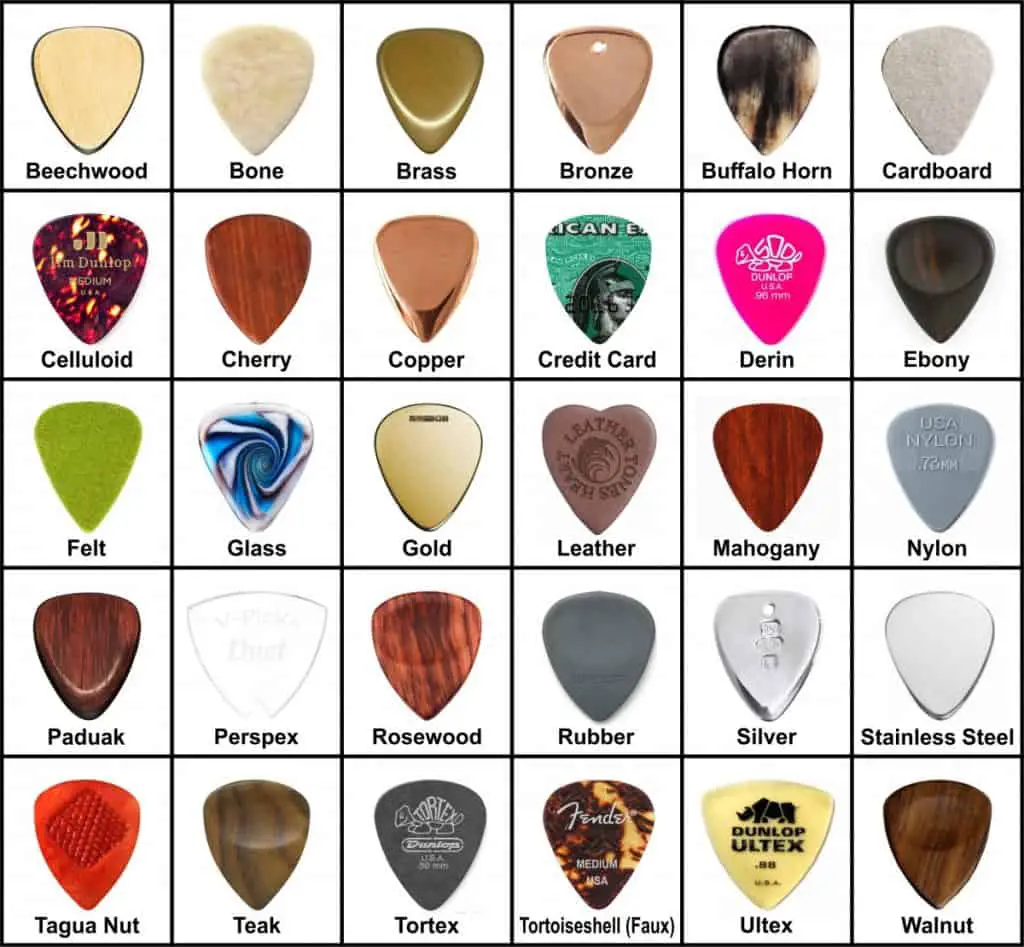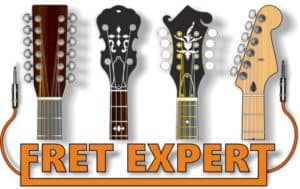I could make this the shortest article on record with a resounding ‘yes, you need a pick on a uke’, but the answer isn’t quite as straightforward as that.
What I will do, though, is to put the case for both sides of the debate and hopefully provide you with enough pointers to help you to decide where you want to take your playing in this regard.
You only have to search the internet for pick or plectrum (the plural is plectra) and up will pop multiple pages of differently shaped models, manufactured from all manner of materials in a variety of weights and thicknesses.
This is a good starting point, but you needn’t limit yourself to uke-only picks.
For a beginner, particularly a child, it’s a good idea to try to find a ukulele pick with a degree of flexibility in it, rather than an unforgiving model manufactured from unbendable plastic, wood, bone or metal.
The more rigidity the pick possesses, the more difficult it will be to maneuver it up and down the strings, particularly with chordal playing in mind.
Obviously, playing technique comes into play as well, so a loose wrist, combined with a nice flexible pick will suit beginners a lot better than a rigid pick and a lot of tension in your arm and wrist. Relaxation is the name of the game in this respect!

Picks are manufactured from a variety of materials including:
- Bone
- Cardboard
- Felt
- Glass
- Horn
- Leather
- Metal (Stainless Steel, Brass, Copper, Silver & Gold)
- Plastic (Nylon, Celluloid, Perspex, Delrin [Acetal Resin], Ultex [Polyetherimide] and others)
- Rubber
- Stone
- Tortoiseshell (real and faux – such as Dunlop’s ‘Tortex’ [similar to Ultex])
- Tagua (a type of nut)
- Wood (Rosewood, Mahogany, Walnut, Cherry, Beech, Paduak & other hardwoods)
For the pick of my thoughts on picking the right pick (or not!), the following information should provide a starting point on the plusses and minuses on the use of a plectrum!
Covered in this Article:
Can You or Should You Use a Pick on a Ukulele?
The main drawback of playing your ukulele with a pick is that it can limit any fingerstyle picking technique you may wish to employ, as it only allows the plucking of one string at a time. That is, unless you develop some wildly complicated mix of the two!
On the plus side, playing with a pick will add a lot more attack to lead or melody playing, as it will cut through a live or recorded mix.
Also, if you rely on fingernails (which I largely do), your playing will be severely curtailed should you break a nail in day to day living situations – something I’m not exactly unfamiliar with!
A prime example of great picking technique can be seen by watching many of the YouTube videos featuring The Ukulele Orchestra of Great Britain (George Hinchliffe, Richie Williams & Ben Rouse, among other members).
So should you use a pick? It’s entirely up to you. When it comes to playing technique on the ukulele and any other fretted instrument for that matter, I feel life is too short to get caught up in some pointless philosophical debate on maintaining traditions by adopting this or that method of playing.
I’m sure the purists mean well in one sense, but in the end it doesn’t add up to a row of beans if you prefer playing with a pick or if you don’t.
Pomposity is there to be punctured and NOT encouraged, so if someone at your ukulele club or group starts tut-tutting at your pick, I would politely and as respectfully as possible urge them to get a life!
Do You Need a Pick to Play Ukulele?
In short, the answer is an unequivocal ‘no’, you don’t need a pick to play the ukulele. A beginner (or a player of any standard for that matter), can happily get by using the digits they were born with – your own built-in plectra! (or picks).
Arguably, the ukulele is at its sweetest when played with the pads of the fingers. This technique is favored by most musicians brought up in the Hawaiian tradition.
One point which I should make on this subject is that beginners in particular may have to resort to a plectrum, should they develop a blister through over-playing or damage to the strumming/picking fingers in some way.
The sensible thing as far as over-playing goes is to limit your practice until your fingers toughen up with calluses. In reality, we aren’t always sensible, so a pick is a good standby, even if you only use it intermittently. For more on this, check out my blog post on ways to prevent finger pain when playing.
Are Ukulele and Guitar Picks the Same?
There are a number of dedicated ukulele picks available, but you don’t have to limit yourself to these if you find something else that suits your playing style better.
My advice would be to visit your local music store, if you can and buy a selection of different types of pick.
Ukulele and guitar picks are not always the same. To differentiate between ukulele and guitar picks in particular, a lot of guitarists like the rigidity of a pick manufactured from a much harder material such as stiff plastic, metal, bone etc.
This applies mainly, although not exclusively to electric and acoustic steel-stringed guitars. You can apply this same thinking to electric steel-stringed ukuleles too – the strings are basically the same but on a smaller instrument with a different scale length (nut to saddle length).
Why Use a Felt or Leather Pick for a Ukulele?
The are several reasons why a felt or leather pick might be a good option for some ukulele players. Firstly, they’re a lot less abrasive than harder substances such as plastic or metal. Even wood or bone will shorten the life of your strings considerably.
Felt and leather on the other hand are altogether softer materials. I should point out though, that there are two main types of felt pick. The first and most readily available are stiff felt picks, which have very little give in them. These don’t suit everyone, but will still extend the life of your strings.
The other type of felt pick which are a lot harder to source these days are made from pure thick felt without any stiffening material applied. These are particularly effective for a young child to start off with. The only downside with this type of pick is the sound will have very little attack, compared with stiff felt or fingers.
DIY Ukulele Picks: What Can I Use as a Uke Pick?
When it comes to ingenuity, fretted instrument players don’t tend to limit themselves to commercially produced plectra or least will go down the experimental route at some point in their musical journey.
A popular pick substitute among a number players are regular minted coins, including Pennies and Quarters. They are a little unforgiving for those who worry about the longevity of their strings, but will give your lead playing in particular, a lot more attack.
Cut up credit cards are also a popular port of call when it comes to fashioning your own designer pick. They’re very easy to make, by using an existing pick as a template and then just cutting around the pen line with a sharp pair of scissors. You may have to sand the edges a bit, but it’s a great low tech solution.
I’ve heard that some people have used CDs and DVDs, but having never gone down this route, I’d image it might require something like a fretsaw to cut. By all means give it a try, but it seems a lot of fuss when other materials are a lot easier to work with.
When I was in my teens and just starting out in music, I spent quite a bit of my spare time making plectra out of all kinds a weird materials (primarily for guitar at this stage).
A favorite method was to glue varying weights of cardboard together and then covering them in felt, very much like the commercially available felt picks available today. I will say they didn’t have great longevity, but were surprisingly effective for a week or two. You could also get an interesting effect when the layers of cardboard eventually started separating.
Another avenue to go down is the use of a pick or plectrum punch. These are very much like the punches used by people in the crafting world, but a heavier duty solution that can cope with material as hard the plastic used in credit cards. The most popular (below) is the Pick-a-Palooza set, available at Amazon.

You can also use them to make cardboard picks, much like the short term solution I mentioned in the above paragraph.
Some plastic food packaging can be adapted as well, but avoid brittle plastic as it’s hard to work with and broken shards can easily snap off when you’re playing and potentially fly up into you eye. Dish soap or plastic milk bottles are ideal D.I.Y. pick material for this purpose as they’re quite flexible.
A few pick suggestions available directly from Amazon.com include:
Lohanu Leather Picks: A nice triangular pick with the center cut out for a better grip.
Mibow Felt Picks: A competitively priced set of stiff-colored felt picks with plenty of attack, but without the ‘thwack’ associated with plastic picks.
Dunlop Nylon Standard Pick .60mm ((44R): A medium weight durable nylon pick with a bobbled surface for better grip.
Dunlop Nylon Standard Pick .38mm (44P): A lightweight nylon pick with a nice degree of flexibility for less experienced players or those wanting more a twangy sound from their uke.
In closing, there really are no rights and wrongs regarding whether you should or shouldn’t use a pick on your ukulele.
Equally, you don’t have to limit yourself to commercially manufactured plectra, should you decide to adopt this playing style.
A lot of ukulele professionals and advanced players are great proponents of a pick, whilst others prefer the more traditional fingerstyle method.
As I mentioned earlier, if you do go down the pick route, be prepared for a more regular string replacement routine. It’s not for everyone, but can be a great tool in your arsenal of playing techniques.
In the end, the type or model of pick you use is very much down to personal preference. What suits one person may feel awkward or uncomfortable to another, so don’t be surprised if you get through several before arriving the perfect pick for you!




